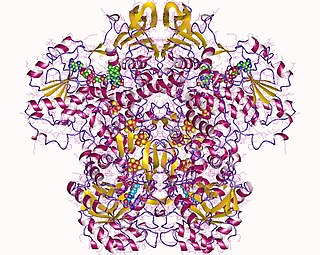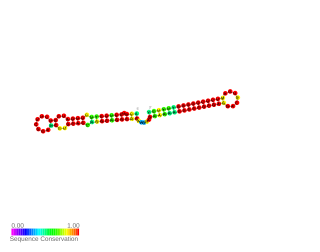
Superoxide dismutase (SOD, EC 1.15.1.1) is an enzyme that alternately catalyzes the dismutation (or partitioning) of the superoxide (O−
2) anion radical into normal molecular oxygen (O2) and hydrogen peroxide (H
2O
2). Superoxide is produced as a by-product of oxygen metabolism and, if not regulated, causes many types of cell damage. Hydrogen peroxide is also damaging and is degraded by other enzymes such as catalase. Thus, SOD is an important antioxidant defense in nearly all living cells exposed to oxygen. One exception is Lactobacillus plantarum and related lactobacilli, which use a different mechanism to prevent damage from reactive O−
2.

The Korarchaeota is a proposed phylum within the Archaea. The name is derived from the Greek noun koros or kore, meaning young man or young woman, and the Greek adjective archaios which means ancient. They are also known as Xenarchaeota. The name is equivalent to Candidatus Korarchaeota, and they go by the name Xenarchaeota or Xenarchaea as well.

Thermus is a genus of thermophilic bacteria. It is one of several bacteria belonging to the Deinococcota phylum. Thermus species can be distinguished from other genera in the family Thermaceae as well as all other bacteria by the presence of eight conserved signature indels (CSIs) found in proteins such as adenylate kinase and replicative DNA helicase as well as 14 conserved signature proteins (CSPs) that are exclusively shared by members of this genus.

Streptomyces is the largest genus of Actinomycetota, and the type genus of the family Streptomycetaceae. Over 700 species of Streptomyces bacteria have been described. As with the other Actinomycetota, streptomycetes are gram-positive, and have very large genomes with high GC content. Found predominantly in soil and decaying vegetation, most streptomycetes produce spores, and are noted for their distinct "earthy" odor that results from production of a volatile metabolite, geosmin. Different strains of the same species may colonize very diverse environments.
QPNC-PAGE, or QuantitativePreparativeNativeContinuousPolyacrylamideGel Electrophoresis, is a bioanalytical, one-dimensional, high-resolution and high-precision electrophoresis technique applied in biochemistry and bioinorganic chemistry to separate proteins quantitatively by isoelectric point and by continuous elution from a gel column.

Dihydrolipoamide dehydrogenase (DLD), also known as dihydrolipoyl dehydrogenase, mitochondrial, is an enzyme that in humans is encoded by the DLD gene. DLD is a flavoprotein enzyme that oxidizes dihydrolipoamide to lipoamide.
Alteromonas is a genus of Pseudomonadota found in sea water, either in the open ocean or in the coast. It is Gram-negative. Its cells are curved rods with a single polar flagellum.

In enzymology, a dihydropyrimidine dehydrogenase (NADP+) (EC 1.3.1.2) is an enzyme that catalyzes the chemical reaction
Streptomyces scabiei is a streptomycete bacterium species found in soils around the world. Unlike most of the 500 or so Streptomyces species it is a plant pathogen causing corky lesions to form on tuber and root crops as well as decreasing the growth of seedlings. Along with other closely related species it causes the potato disease common scab, which is an economically important disease in many potato growing areas. It was first described in 1892, being classified as a fungus, before being renamed in 1914 and again in 1948. Several other species of Streptomyces cause similar diseases to S. scabiei but other, more closely related species, do not.
Leptospira santarosai is a pathogenic species of Leptospira.
Streptomyces acidiscabies is a streptomycete bacterium species, causing a scab disease of potatoes. Its type strain is RL-110.

Nickel superoxide dismutase (Ni-SOD) is a metalloenzyme that, like the other superoxide dismutases, protects cells from oxidative damage by catalyzing the disproportionation of the cytotoxic superoxide radical to hydrogen peroxide and molecular oxygen. Superoxide is a reactive oxygen species that is produced in large amounts during photosynthesis and aerobic cellular respiration. The equation for the disproportionation of superoxide is shown below:
Streptomyces cellulolyticus is a cellulolytic bacterium species from the genus of Streptomyces.
Streptomyces stramineus is a bacterium species from the genus of Streptomyces which has been isolated from American grassland soil. It produces phleomycin.
Streptomyces thermoalcalitolerans is a bacterium species from the genus of Streptomyces which has been isolated from garden soil in Yogyakarta on Indonesia.
Streptomyces xinghaiensis is a bacterium species from the genus of Streptomyces which has been isolated from marine sediments from Xinghai Bay near Dalian in China.

s-SodF RNA is a non-coding RNA (ncRNA) molecule identified in Streptomyces coelicolor. It is produced from sodF mRNA by cleavage of about 90 nucleotides from its 3′UTR. However it does not affect the function of sodF mRNA, but It acts on another mRNA called sodN. s-SodF RNA has a sequence complementary to sodN mRNA from the 5′-end up to the ribosome binding site. It pairs with sodN mRNA, blocks its translation and facilitates sodN mRNA decay. In Streptomyces sodF and sodN genes produce FeSOD and NiSOD superoxide dismutases containing Fe and Ni respectively. Their expression is inversely regulated by nickel-specific Fur-family regulator called Nur. When Ni is present Nur directly represses sodF transcription, and indirectly induces sodN.
Pseudonocardia kongjuensis is a bacterium from the genus of Pseudonocardia which has been isolated from a gold mine near Kongju on Korea.
Pseudonocardia spinosispora is a bacterium from the genus of Pseudonocardia which has been isolated from soil from a gold mine in Kongju on Korea.
Catelliglobosispora koreensis is a species of bacteria from the family Micromonosporaceae. Catelliglobosispora koreensis has been isolated from soil from a gold mine cave from Kongju in Korea.







